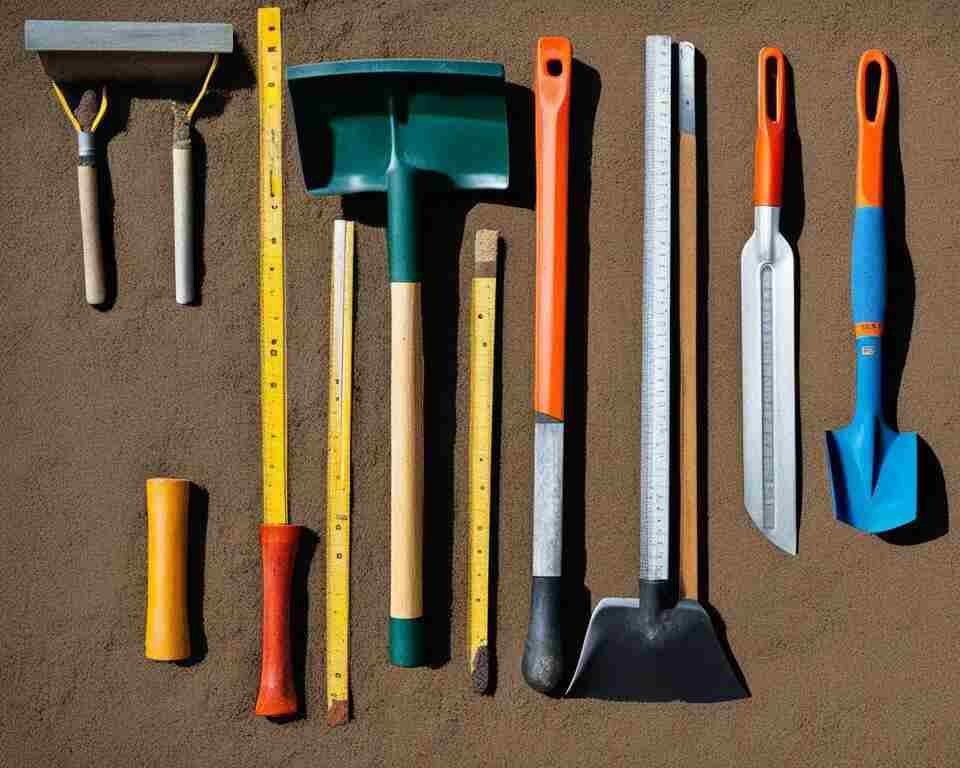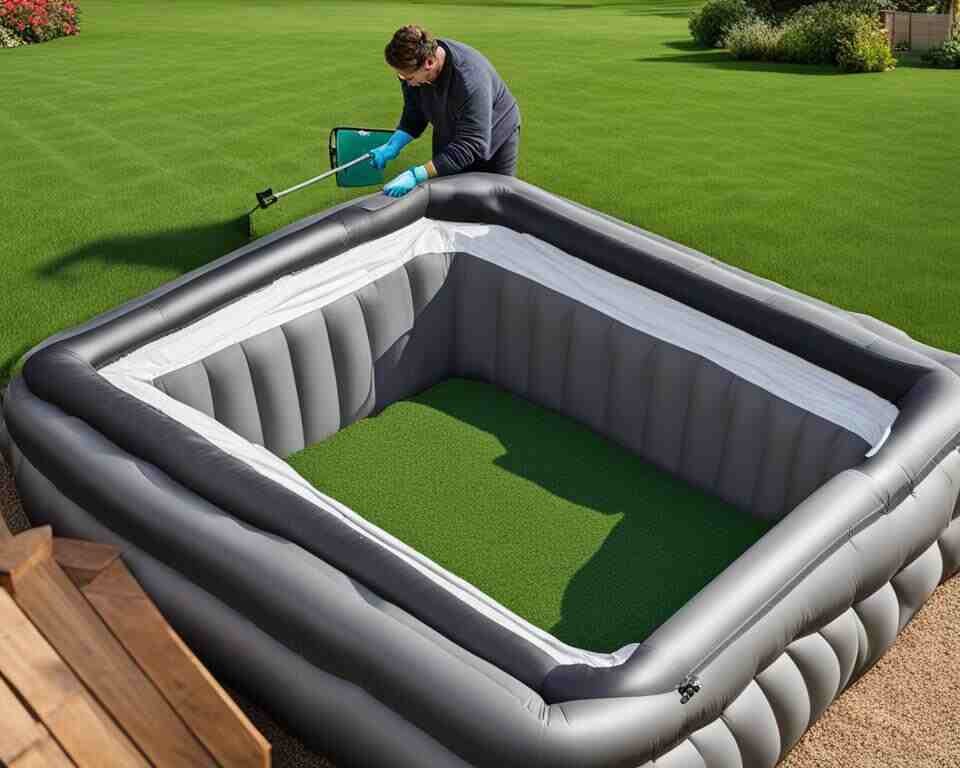In this comprehensive guide on “How to Level Ground for Inflatable Hot Tub,” I will lead you through the essential steps to create a sturdy foundation for your hot tub. Whether you’re a newcomer to hot tub installation or have some prior experience, this guide is crafted to equip you with all the necessary information.
Key Takeaways:
- Critical Foundation: A level base is essential for hot tub stability, preventing damage and ensuring a safe and enjoyable experience.
- Challenges and Solutions: Identifying uneven areas and achieving perfect levelness can be challenging, but using proper techniques and tools can overcome these issues.
- Essential Tools: Shovels, rakes, measuring tools, leveling devices, gravel, or sand are crucial for efficient ground leveling.
- Maintenance is Key: Regularly inspect the ground for shifts or sinking to maintain long-term stability and prevent potential damage to the hot tub.

Understanding the Importance of a Level Base for Your Hot Tub
Before diving into the process of leveling the ground for your inflatable hot tub, it’s crucial to understand why it’s important. A level base provides the necessary stability and support for your hot tub, ensuring a safe and enjoyable experience. Let’s explore the impact of uneven ground on inflatable hot tubs, the common challenges you may face when leveling the ground, and the benefits of properly preparing your hot tub foundation.
The Impact of Uneven Ground on Inflatable Hot Tubs
Uneven ground can have a significant impact on the performance and longevity of your inflatable hot tub. When a hot tub is placed on uneven ground, it places uneven stress on the tub’s structure. Over time, this can lead to deformation, leaks, and even irreversible damage. Additionally, uneven ground can cause water to pool in certain areas, making it uncomfortable to sit or move around in the hot tub.
Common Challenges with Inflatable Hot Tub Ground Leveling
Leveling the ground for an inflatable hot tub can present some challenges. One common challenge is identifying the areas that require leveling. Depending on the terrain, you may need to remove rocks, roots, or other objects that could affect the stability of the hot tub. Another challenge is achieving a perfectly level surface, especially if the ground has significant slopes or variations. However, with the right techniques and tools, these challenges can be overcome.
Benefits of Properly Preparing Your Hot Tub Foundation
Properly preparing your hot tub foundation offers several benefits. First and foremost, it ensures the safety of the users. A level base minimizes the risk of accidents and injuries caused by an unstable hot tub. Additionally, a level foundation promotes better water circulation within the tub, enhancing the overall performance of the hot tub’s heating and filtration systems. Finally, a well-prepared foundation can prevent damage to the hot tub itself, extending its lifespan and saving you money on repairs or replacements in the long run.
To fully grasp the significance of leveling the ground for your inflatable hot tub, it’s important to understand the impact of uneven ground, the challenges involved, and the benefits of a properly prepared foundation. Armed with this knowledge, you can proceed with confidence and ensure a secure and long-lasting installation for your hot tub.
Essential Tools and Materials for Ground Leveling
To level the ground for your inflatable hot tub, you’ll need some specific tools and materials. Having the right equipment at hand will ensure a smooth and efficient process. Here are the essential tools and materials required for ground leveling:
- Shovels – to dig and move soil
- Rakes – to level and smooth the ground
- Measuring tools – to accurately measure the slope and ensure levelness
- Leveling devices – such as a bubble level or laser level, to achieve precise leveling
- Gravel or sand – for creating a solid foundation for your hot tub

| Tool/Material | Description |
|---|---|
| Shovels | Used for digging and moving soil. A flat shovel works well for cutting through sod and removing excess dirt. |
| Rakes | Used for leveling and smoothing the ground. A landscape rake with sturdy metal tines is preferable for removing debris and creating an even surface. |
| Measuring tools | Essential for accurately measuring the slope of the ground and ensuring levelness. A measuring tape or laser measuring device can be used for precise measurements. |
| Leveling devices | Devices such as a bubble level or laser level help achieve an accurately leveled surface for the hot tub. These tools ensure that the ground is perfectly level in all directions. |
| Gravel or sand | Used as base materials for creating a solid foundation. Gravel provides stability and drainage, while sand helps in achieving a level surface. |
Ground Preparation Techniques for Inflatable Hot Tubs
Clearing the Area: Removing Debris and Vegetation
Before you begin leveling the ground for your inflatable hot tub, it is essential to clear the area of any debris and vegetation. This step is crucial as it ensures a clean and even surface for the installation process. Removing debris such as rocks, branches, and grass will prevent any obstructions that may interfere with the stability of your hot tub. It is recommended to thoroughly inspect the area and clear it of any potential hazards.
Assessing and Measuring Slope for Adjustments
Assessing and measuring the slope of the ground is vital in determining the adjustments required for a level base. Use a measuring tool, such as a level or a slope gauge, to accurately evaluate the slope. It is important to note that even a slight slope can affect the stability and functionality of your hot tub.
If the slope is within an acceptable range, you can proceed with the leveling process. However, if the slope is too steep, you may need to consider additional measures such as terracing or constructing a retaining wall to ensure a stable installation.
Choosing the Right Base Materials: Gravel or Sand?
When it comes to selecting the base materials for your hot tub foundation, three popular options are gravel, sand and concrete. Both materials have their advantages and considerations, so it’s crucial to choose the one that best suits your specific needs.
- Gravel: Gravel is a commonly used base material as it provides excellent drainage and stability. It is especially suitable for areas with heavy rainfall or high groundwater levels. The gravel size should be chosen to ensure proper support, typically ranging from 3/8 to 3/4 inches. Additionally, using a geotextile fabric beneath the gravel can help prevent weed growth and ensure long-term stability.
- Sand: Sand is another popular choice for hot tub bases due to its level surface and ease of installation. It provides good support and can be easily leveled to create a smooth foundation. However, it may not offer the same level of drainage as gravel and may require more frequent maintenance to prevent erosion and shifting.
- Concrete: Concrete is a robust and enduring choice for hot tub foundations. It provides a stable and level surface that can withstand heavy loads and varying weather conditions. The longevity of concrete eliminates concerns about erosion or shifting over time, offering a low-maintenance solution. To ensure optimal performance, consider reinforcing the concrete with mesh or rebar. While the initial installation may require more effort, the long-term durability and stability make concrete a reliable choice for your hot tub base.
Ultimately, the choice between gravel, sand or concrete will depend on your specific terrain, climate, and preferences. Consider consulting with a professional or referring to the manufacturer’s recommendations for your specific inflatable hot tub.
Step-by-Step Process of Leveling the Ground
In this section, I will guide you through the step-by-step process of leveling the ground for your inflatable hot tub. By following these instructions, you’ll ensure a stable and secure foundation for your hot tub setup.
Marking Your Hot Tub Area and Creating a Leveling Guideline
The first step in leveling the ground is to mark the area where you want to place your hot tub. Using stakes and string, create an outline that represents the dimensions of your hot tub. This will serve as a guideline to ensure accurate leveling.

Adjusting for Slopes: Digging and Filling Strategies
Next, assess the slope of the ground and determine the adjustments needed to level it. If the ground has a slope, you may need to dig into the higher areas and fill in the lower areas to create a level surface. Gradually add or remove soil as necessary until the ground is leveled.
When digging, make sure to remove any rocks, roots, or debris that may interfere with the stability of the ground. Use a shovel or an excavator to loosen the soil and create a smooth surface before filling in the lower areas.
Tamping for Stability: Ensuring a Firm and Durable Surface
Once the ground is leveled, it’s important to tamp it down for stability. Use a hand tamper or a plate compactor to firmly pack the soil and create a solid base for your hot tub.
Tamping helps to eliminate any air pockets and ensures that the ground is compacted, preventing it from settling or shifting over time. Repeat the tamping process in multiple directions to achieve an even and stable surface.
| Step | Process |
|---|---|
| 1 | Mark the area for your hot tub using stakes and string. |
| 2 | Assess the slope of the ground and make necessary adjustments by digging into higher areas and filling in lower areas. |
| 3 | Remove any rocks, roots, or debris from the ground. |
| 4 | Tamp the soil using a hand tamper or plate compactor to create a firm and stable surface. |
By following these step-by-step processes of marking your hot tub area, adjusting for slopes, and tamping the ground, you’ll be able to level the ground effectively and ensure a solid foundation for your inflatable hot tub.
How to Level Ground for Inflatable Hot Tub
In this section, I will explore different techniques for leveling the ground to ensure a stable base for your inflatable hot tub. By following these methods, you can create a secure foundation that will enhance the stability and durability of your hot tub installation.
Using Shims for Minor Adjustments
If you encounter small variations in the ground level, shims can be an effective solution for making only minor adjustments. Shims are thin wedges or tapered pieces of material that can be placed under the hot tub to even out any unevenness.
To use shims, assess the areas where the ground is not level and determine the thickness of shims required. Place the shims strategically beneath the hot tub legs to balance the tub and achieve a level surface. Ensure that the shims are made of durable and weather-resistant materials to withstand the weight of the hot tub over time.
Creating Custom Platforms: DIY Options and Precautions
If your hot tub is situated on uneven ground, creating custom platforms can provide a stable base for your hot tub. With some basic woodworking skills and materials, you can build platforms that are tailored to fit the contours of your terrain.
When constructing custom platforms, it is crucial to take necessary precautions to ensure safety and stability. Use pressure-treated lumber or other suitable materials that are resistant to moisture and insects. Additionally, follow building codes and regulations to ensure the structural integrity of the platforms.
Effective Use of Spa Pads and Hot Tub Levelers
Another option for leveling the ground for your hot tub is to use spa pads and hot tub levelers. These products are specifically designed to provide stability and support for hot tub installations.
Spa pads are durable, interlocking pads that can be placed directly on the ground to support and level the hot tub. They are resistant to chemicals, moisture, and temperature variations, making them ideal for outdoor use. Hot tub levelers, on the other hand, are adjustable supports that can be placed beneath the hot tub legs to achieve a level position.
When using spa pads and hot tub levelers, carefully follow the manufacturer’s instructions to ensure proper installation. Regularly inspect and maintain these accessories to ensure they continue to provide the necessary stability for your hot tub.

Addressing Challenges: Tips for Hot Tub Installation on Sloped Surfaces
Installing a hot tub on a sloped surface can present unique challenges. Whether you’re dealing with a slight incline or a steep hill, it’s essential to take the necessary steps to ensure a level base for your hot tub. In this section, I will provide you with valuable tips and techniques to address these challenges and successfully install a hot tub on a slope.
One of the main challenges of hot tub installation on sloped surfaces is achieving a stable and level foundation. The uneven terrain can make it difficult to position the hot tub securely. However, with the right approach and careful planning, you can overcome these obstacles and create a safe and enjoyable hot tub area.
Here are some tips for installing a hot tub on a slope:
- Survey the slope: Before starting the installation process, thoroughly examine the slope to understand its angle and steepness. This will help you determine the required adjustments and preparation steps.
- Level the ground: Begin by leveling the ground as much as possible. Remove any rocks, debris, or vegetation that may hinder the leveling process.
- Create a sturdy base: Building a solid base is crucial for a hot tub on a slope. Consider using retaining walls or terracing to create flat and stable platforms at various levels. This will provide a secure foundation for your hot tub.
- Use leveling tools: Invest in high-quality leveling tools, such as a bubble level or laser level, to ensure accurate measurements and adjustments. This will help you achieve a level base for the hot tub.
- Add support: Depending on the slope’s severity, additional support may be required. Consider using adjustable support pads or leveling feet to compensate for any irregularities.
- Secure the hot tub: Once the base is leveled and secure, carefully position the hot tub on top. Ensure that it aligns properly with the support structure and is firmly anchored in place.
By following these tips, you can overcome the challenges of hot tub installation on sloped surfaces and enjoy a secure and level hot tub area. Remember to take your time, plan the installation process carefully, and seek professional assistance if needed.
Now that you have learned how to address the challenges of installing a hot tub on a slope, let’s move on to the final section of this guide where we summarize the key takeaways and provide maintenance tips for long-term stability.
Conclusion
In conclusion, leveling the ground for your inflatable hot tub is a crucial step in ensuring a safe and stable installation. By following the key takeaways outlined in this guide, you can create a solid foundation for your hot tub and enjoy a worry-free experience.
Maintaining long-term stability requires regular maintenance and checks. It is important to periodically inspect the ground for any signs of shifting or sinking. By addressing any issues promptly, you can prevent further damage and ensure the longevity of your hot tub.
For a successful inflatable hot tub setup, I recommend adhering to the following final recommendations:
- Use the appropriate tools and materials for ground leveling to achieve a level base.
- Clear the area of debris and vegetation, assess the slope, and choose the right base materials.
- Follow the step-by-step process outlined in this guide, marking the hot tub area and adjusting for slopes.
- Consider using shims, creating custom platforms, or using spa pads and hot tub levelers for additional stability.
- Install on a level surface whenever possible, but if installing on a slope, follow the tips provided in this guide.

